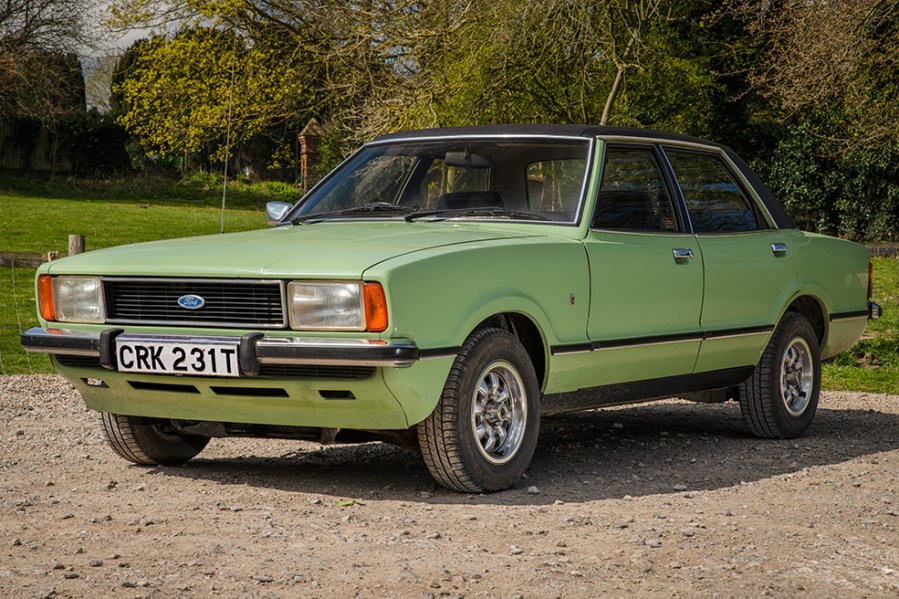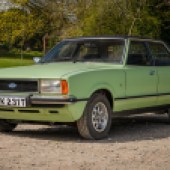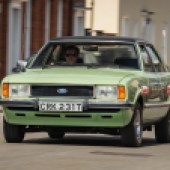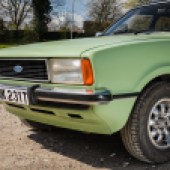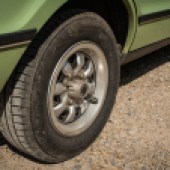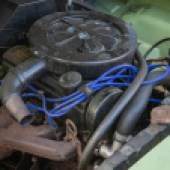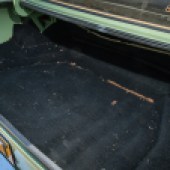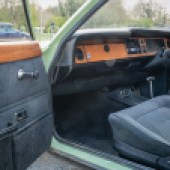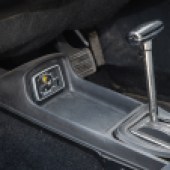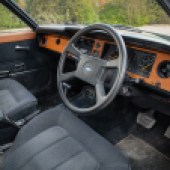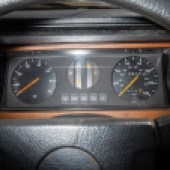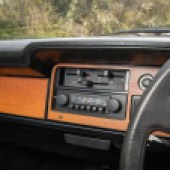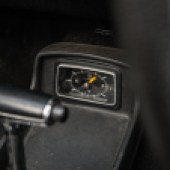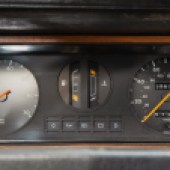Having started the 70s with a boxy Cortina, Ford ended the decade in much the same way. Here’s how to find a good one
The Mk3 Cortina’s American-inspired ‘Coke bottle’ was band on-trend when it hit showrooms in 1970, but after several years of sustained success at the top of the sales charts, buyers were craving something new. In 1976 the Mk3 Cortina was narrowly knocked off the top step by rivals for the first time in half a decade – but by then Ford had already dusted off its straight edge to sharpen things up again.
The fourth-generation Cortina, launched in September 1976, was an evolution rather than a revolution. The outgoing Mk3, while hardly a pioneer in terms of tech, had ushered in significant change. It was significantly larger than its Mk1 and Mk2 predecessors, and shared the same platform as the similar-looking but less curvaceous Taunus TC sold by Ford Germany. It was a gamble, but one that paid off, so when it came to the Mk4, Ford kept the same dependable underpinnings and combined them with a squared-off exterior styled by Uwe Bahnsen, who would later produce the Sierra. The new body brought the Cortina up to date and satisfied the desires of the fleet market, but its looks were hardly a surprise – the new ’76 Taunus TC2 had already been around for seven months and was now the same car with a different badge.
The crisper styling gave the Cortina a greater glass area of up to 15 per cent, which made it feel lighter and roomier inside. There were also new trim materials and a fresh steering wheel design, but the dash and seating positions were carried over from the facelift Mk3. The engines were also carried over, as from launch the Mk4 was available with 1.6 and 2.0-litre SOHC Pinto engines, as well as the 1.3-litre Kent OHV motor.
Ford was well versed in the art of badge hierarchies by this point, with the Mk4 collecting the baton and running with it. Depending on the engine size and which of the two-door, four door or estate body options you went for, you could choose from base, L and GL, together with the sporty new S model and the plush wood and velour-clad Ghia, which replaced the old E model.
The GL, S and Ghia also got a new engine option in 1977 with the introduction of the 108bhp 2.3-litre Cologne V6. Though refined, it was not that much quicker that the 97bhp 2.0-litre in reality, wasn’t as economical and didn’t sell nearly as well in comparison.
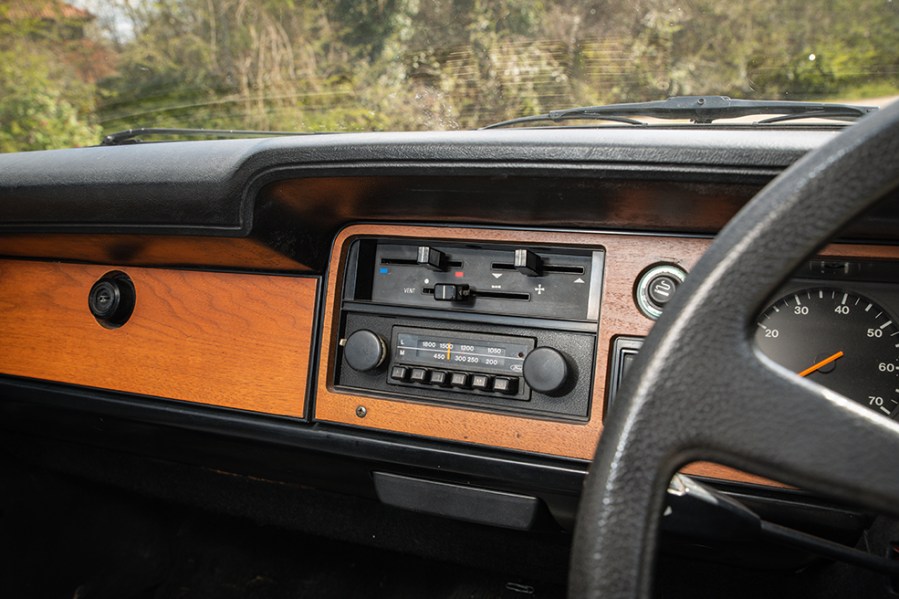
Despite it sharing much of the Mk3’s DNA, buyers really took to the Mk4 and it was reinstated at the top of the sales charts. An impressive 600,000 were sold before the Cortina 80, codenamed Teresa and commonly known as the Mk5, was announced in August 1979. At first glance it looked little different from the Mk4, but it boasted a higher roofline, once again boosting the glass area, and a deeper front valance.
In addition, there were new bumpers and wrap-round front indicators sunk into revised wings, bigger, ribbed tail lamp lenses, a more aerodynamic radiator grille and larger plastic external door mirrors. Notably, there were new rust-proofing measures and improved trim levels, though the dash was still recognisable from the late Mk3.
The Mk4’s well-proven engine line-up was carried over, though all models received a viscous coupled thermostatic fan and the 1.3-litre and 1.6-litre engines got the infamous Motorcraft ‘Variable Venturi’ carburettor. The 2.3-litre V6 gained electronic ignition, better cylinder heads and a higher compression ratio to boost power to 114bhp. The only change to trim levels was the deletion of the S version — instead, an S pack was offered with auxiliary driving lights, uprated suspension, an S gear knob and the all-important S badge for the rear.
Although a little dated, the Cortina 80 performed as Ford had hoped, remaining the UK’s best-seller. It wasn’t until its final year of 1982 that it would be knocked off its perch by the Escort. Even then, the Crusader run-out edition, complete with its two-tone paint and Ghia trim proved to be very popular – 30,000 were produced in the run-up to the launch of the Cortina’s radical new Sierra replacement. The very last Cortina – a silver Crusader – rolled off the Dagenham production line in July 1982, but high stocks meant sales continued into 1983 and beyond.
Bodywork
As is the case with so many classics from the 1970s, common rust spots include the rear chassis rails, inner rear crossmember, backs of the sills, rear valance, lower rear quarters, rear aches, spare wheel well and the boot floor where the bumper mounts are, as well as the Estate’s tailgate. Basically, it pays to undertake a very thorough inspection – and expect to find plenty of areas that need attention on all but the most pristine, freshly restored examples.
The area where the car’s A-pillars and kick panels adjoin, the windscreen surrounds and scuttle, front jacking points and front valance can also suffer. Under the bonnet, check the battery tray, the inner wing/bonnet hinge area and where the slam panel meets the wings, together with the top suspension mountings for signs of previous repairs and the condition of the crossmember beneath the front end. Sunroof-equipped cars are prone to rust where the edges of the roof butt up to the seal, while the factory steel sunroof panel itself is very hard to find, too.
Otherwise, availability of new old stock and replacement panels is fairly good, helped by a lot of the metalwork under the skin being shared by the Mk3. Magnum Panels sells several items new, including the front and rear valances, inner and outer sills, the battery tray, rear arches and wing mounting rails, while Ex-Pressed Steel Panels can provide scuttle corners, the boot floor and various floorpan fittings. Pattern Mk4 and Mk5 wings are the right side of £200 apiece but expect to pay more for genuine NOS panels if you can track them down.
In terms of exterior trim, early Mk4 bumper rubber inserts are hard to find, as are Mk5 screen rubbers and side trims. Rubber bumper overriders can also be problem, as the bonded-in mounts rust and split the rubber when undone. These are different front to rear, and new ones vary wildly in price.
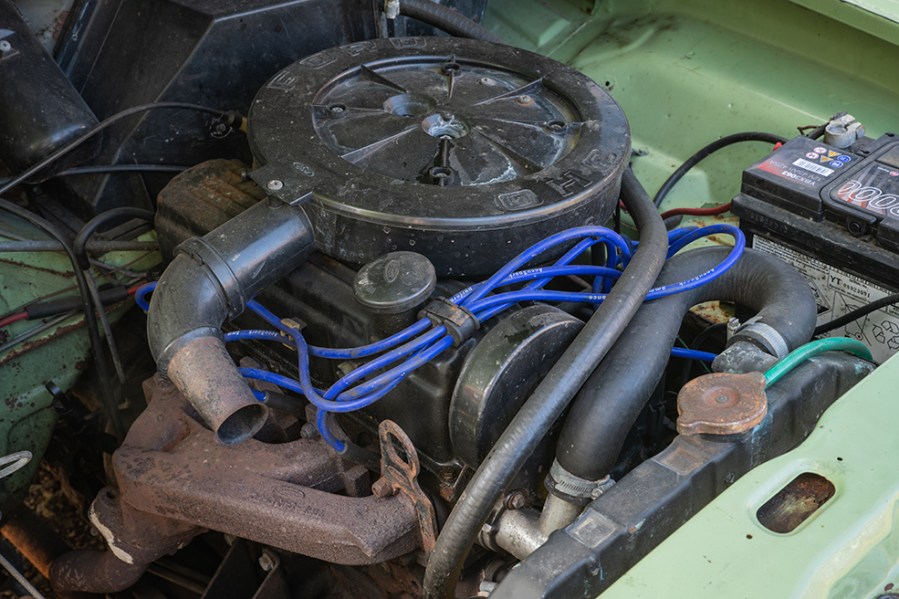
Engine and transmission
All the engines are reliable if they’re looked after, but the Crossflow 1.3 is particularly prone to premature piston and bore wear, so check for blue smoke as an indicator. The 1.6 and 2.0-litre Pintos are more rugged but do suffer from camshaft oil starvation when the oil spray bar becomes blocked, a tapping sound being the giveaway.
Water pumps on Pintos can seize if the wrong mix of anti-freeze has been used, while the VV carburettor can also be hard work to get idling right, with diaphragms and worn spindles causing issues. The Pinto uses a cam belt which should be changed every 30,000 miles although the 2.0 is a ‘safe’ engine should it snap. The flagship 2.3-litre V6 is unstressed but watch for valvetrain noise and overheating, the Cologne tending to crack its heads if it runs too hot.
Most mechanical parts are easily sourced, but single choke carbs for the Mk4 are getting difficult, and good V6 Pierburg carbs likewise. V6 radiators are also hard to find, especially for the Mk4, but a TX1 Taxi item is a good compromise for Mk5. The exhaust for the V6 is easier to source from the Continent, but the down pipes have to be UK-spec for RHD cars.
Originally, you either got a four-speed manual or an optional three-speed Borg-Warner automatic, with the smaller-engined manual cars getting a Type 3 gearbox and the bigger capacity models the stronger Type E version. The manuals are generally reliable, but a tired synchromesh, imprecise gear change and rumbling bearings will indicate if its days are numbered.
The automatic should take up drive smartly and the fluid should look clean – black fluid and a smell of burning indicates trouble. Noises from the rear end are sometimes confused with worn wheel bearings but again, the axles and diffs are generally rugged. Check the diff cover for any corrosion that might be causing leaks and letting the diff run dry.

Suspension, steering and brakes
Ah yes, void bushes. Fitted to the rear trailing arms and diff housing, they are legendary for premature wear — steadily declining handling is a giveaway; being able to easily rock the back of the car from side to side indicates they’re really shot. Poly bushes are the obvious solution, but they make the ride so hard that many owners live with regularly replacing the OE-spec rubber void bushes. Tie-rod bushes are also prone to failure, the tell-tale being a clunking under braking. Most parts are still available new – a situation helped by good old Ford interchangeability – but power-assisted steering racks and the shorter-type steering shafts that fit between the column and the rack are hard to find, new or used.
The front disc and rear drum set-up works well when it’s in good order, and all models came with a servo. An overhaul isn’t the end of the world — new discs, drums, rear wheel cylinders, callipers and calliper rebuild kits are all available and inexpensive. New master cylinders can be harder to source but they can be refurbished with a home DIY kit for circa £15 but be careful to get the right parts as there are a couple of different types.

Interior and electrics
Sourcing plastic mouldings and fabrics for old Fords is tough at the best of times, but its particularly difficult with the late Cortinas. Parts are just too costly to tool up for reproduction manufacture, so repairs are likely to be on a bespoke basis rather than off the shelf. Otherwise, it’s a case of hunting for second-hand parts. The velour on higher-spec models survives better than the thinner cloth on basic cars – the latter being easily torn and prone to sun damage across the top of the rear seat. Replacing black and brown cloth is possible, but other colours are more difficult to find, especially the stripy trim fitted to the Mk4 S. Fortunately, the plastic trim and door cards last well, but look for unsightly speaker holes and damage to the Ghia’s wooden door-cappings.
Dodgy electrics are usually down to corrosion in the fuse box, and the headlight fuse also has a habit of overheating. Second-hand lights are still cheap enough, and things like indicator lenses can be bought new from specialist like Burton Power. The auxiliary Carello driving lights of the S pack are more difficult to source.

Ford Cortina Mk4 & Mk5: our verdict
Once everywhere, these later Cortinas are now exceptionally rare when compared to their predecessors. The Mk5 is easier to find than the Mk4, but if anything tends to be slightly more expensive. Though no longer cheap, Cortina values not have not followed the steer upward trajectory of other contemporary rear-wheel-drive Fords like the Capri or Escort.
The rare Crayford convertibles were scarce to start with, so don’t seem to sell for high prices you may expect, perhaps as they don’t tug the ‘everyman’ nostalgia strings quite like the saloon. It probably pays to buy on condition rather than model, as engine upgrades are easy with Fords of this era.
In the end 523,000 Cortina 80s were built, taking total Mk4/5 production to over 1.1m. The archetypal 1970s and early ’80s family and fleet saloon, they were once on every street and virtually every TV show. However, with numbers since decimated by the contempt of familiarity and the curse of daily use, only a fraction survive. Find a good one, and it’ll be widely admired.

